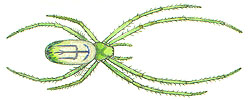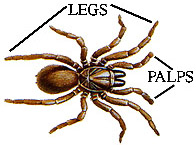 |
|
| You Are Here: Burke Museum : Spider Myths : Weird : Miscellaneous |
Just Plain Weird Stories
Myth: Miscellaneous less common spider myths and legends.
Fact: The following myths, not heard as often
as some others, have been sent in by correspondents since the first appearance
of this site.
The myth that "there are tarantulas that can jump 3-4 feet" (1 meter)
seems to be limited to the American southwest. No tarantula researcher has observed
such an event. Any good-sized tarantula that fell that distance would likely
be seriously injured. I had a Texan tarantula for 9 years in a 6 inch high terrarium
and she never jumped out. Tarantulas can lunge 3-4 centimeters when capturing
prey, but most of their movements are slow. One possible exception: juveniles
of some South American tree-dwelling species, including the "pink toe"
shown on this page, are reportedly able to jump
moderate distances. But North American species are non-jumpers.
A correspondent had heard that "tarantulas crawl out of their skin before
dying." Like all other spiders, tarantulas do molt their "skin"
a number of times while growing, but not just before dying, unless (as sometimes
happens) they die of molt failure. A stranger myth about molting is that "the
brown recluse is the only spider that sheds
its skin." Nope - they all do.
Brown recluses seem to accumulate myths. In 2005 a man reported hearing that they acquired their toxicity through a mutation due to World War II atomic-bomb research. Of course that is nonsense – the toxic component in recluse venom is also present in distant relatives that diverged many millions of years ago. Once in a while you hear a rumor about a supposed cross between a black widow and a brown recluse (those being the only 2 spiders the rumor-monger has ever heard of). These species are so unrelated it would be like a cross between a whale and a walrus.

|
One occasionally hears a report
of a ten-legged spider. One man wrote me that his son had heard about such a
spider on a television documentary. Such reports involve certain spiders of
the mygalomorph (tarantula-like) suborder that have unusually long pedipalps,
which non-arachnologists can mistake for a fifth pair of legs. All spiders have
palps (click
here for a diagram of normal palps), but in the vast majority they are too
small to be mistaken for legs.
Another man's son found a "one-eyed spider" on a web site, but couldn't find the site again. While there is a slight chance of a "freak" spider specimen with only one eye (of the normal 8) present, this is more likely a case of a trapdoor or similar spider, in which the 8 eyes are clustered very close together on a central "bump," easily misinterpreted as a single eye.
A correspondent states that the saying "A spider by day is quite okay,
but a spider at night should cause you flight" was common among early 20th
century European immigrants to New York City. More recently someone wrote in explaining this as a mistranslation of a German saying that begins "Spinnen am Morgen bringt Kummer und Sorgen…" The word Spinnen means both spinning (the usual translation) and spiders.
Persons recovering from Latrodectus (black widow and related species)
bites are sometimes told by well-meaning friends that if they are bitten again
they will probably die! There is no medical basis for such a belief.
Brown widow spiders, Latrodectus geometricus, allegedly appeared for the first time along the gulf coast of the USA due to the severe hurricanes of 2005. Residents of these areas (who already had enough troubles) received multiple warnings about this "dangerous" species. In reality the westward spread of this species from long-established Florida colonies was well under way before 2005. Symptoms of its bite are much less severe than those of black widows that always existed in these areas, so there was no reason for the hype except to sell newspapers.
A correspondent heard the story "baby spiders don't know how to control their venom, and may inject more than an adult" on a California ranch in the early 1990s. Spiders don't actually have to learn biting behavior – they are hatched with all such abilities already hard-wired. And spiderlings don't have enough venom to matter anyway.
A Canadian correspondent has heard people say that stepping on a spider will
bring some catastrophe like bad weather or a broken back. Another writes of hearing this applied to harvestmen in NE Ohio.
A comment posted to an Australian web site states that the venom from a wolf
spider bite "eats a centimetre of skin every month" and "in seven
years ... you could have no arm left." Not only is this medically ridiculous,
but no wolf spiders have been proven to have dangerous venom of any kind.
I've heard the "spider urine" myth once from the USA and several times from
Latin America, where it probably originated. It seems that there are one or
more spider species that urinate on sleeping persons, and the urine, rather
than a bite, causes a skin ulceration. In Guatemala this myth (still going strong in 2008) centers on a tarantula
species locally called araña de caballo (horse spider) which is
said to cause severe hoof and leg trouble in horses and other livestock by urinating
on them. In truth, spiders do not have separate urine and feces, and their droppings
consist largely of guanine, which is a component of DNA and found in all living
things; highly unlikely to cause any skin reaction!
One woman wrote of her husband's belief that "all 'sticky' spider webs
are from poisonous spiders." Quite untrue - the most commonly encountered
webs with sticky silk are made by orbweavers, none of which is medically significant.
Finally, a really strange one: "From time to time, spiders
breed by cloning. That is, the mother makes several clones of herself inside
her body, and when the spiderlings grow they start to eat the mother until the
mother is just an empty shell. You see this sometimes when you try to smash
a spider and out of the smashed spider, hundreds of spiderlings creep out."
At least three later correspondents related this to a real experience of stepping (shame on you!) on a female wolf spider carrying a brood of young on her back. Surviving young would scatter from the maternal corpse, but they weren't inside her.
| Previous Myth | Myths Home | Web Resources | Next Myth |
 |
Text © 2005-2008, Burke Museum of Natural History & Culture, University of Washington, Box 353010, Seattle, WA 98195, USA Phone: 206-543-5590 Photos © as credited |
Queries
to Spider Myths author, Rod Crawford This page last updated 2 September, 2010 This site best viewed at 800 x 600 using IE 5.0 or above. |